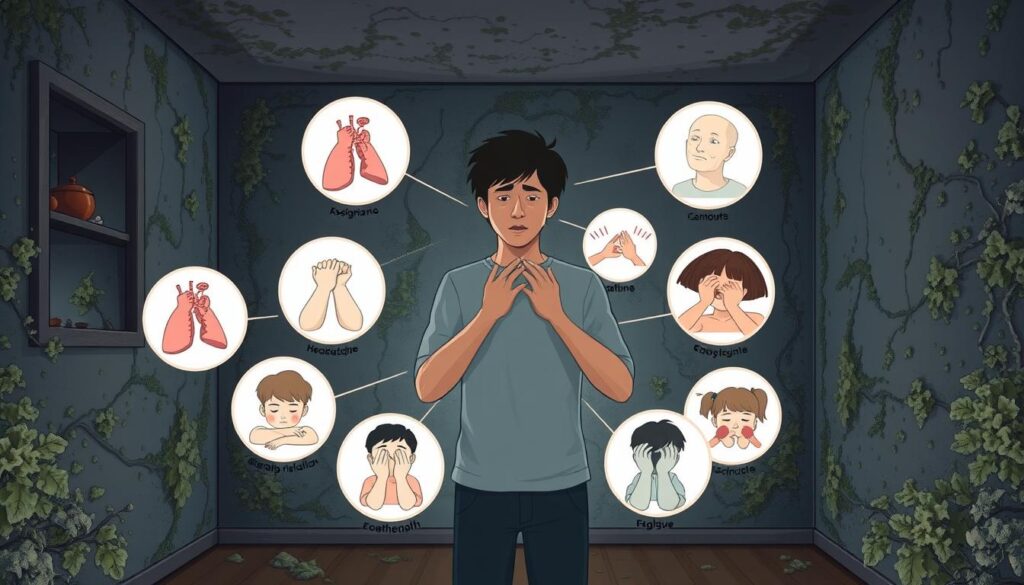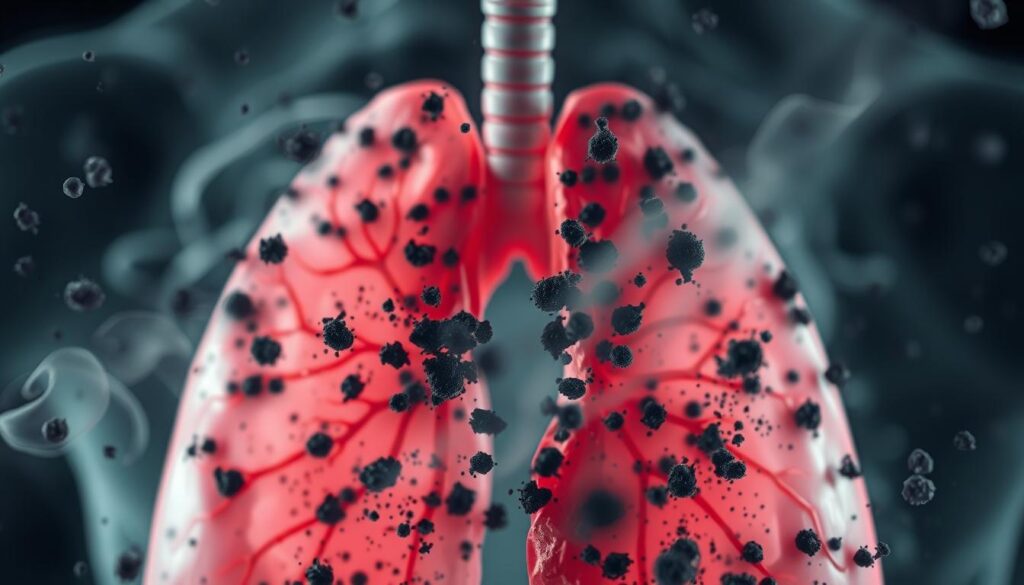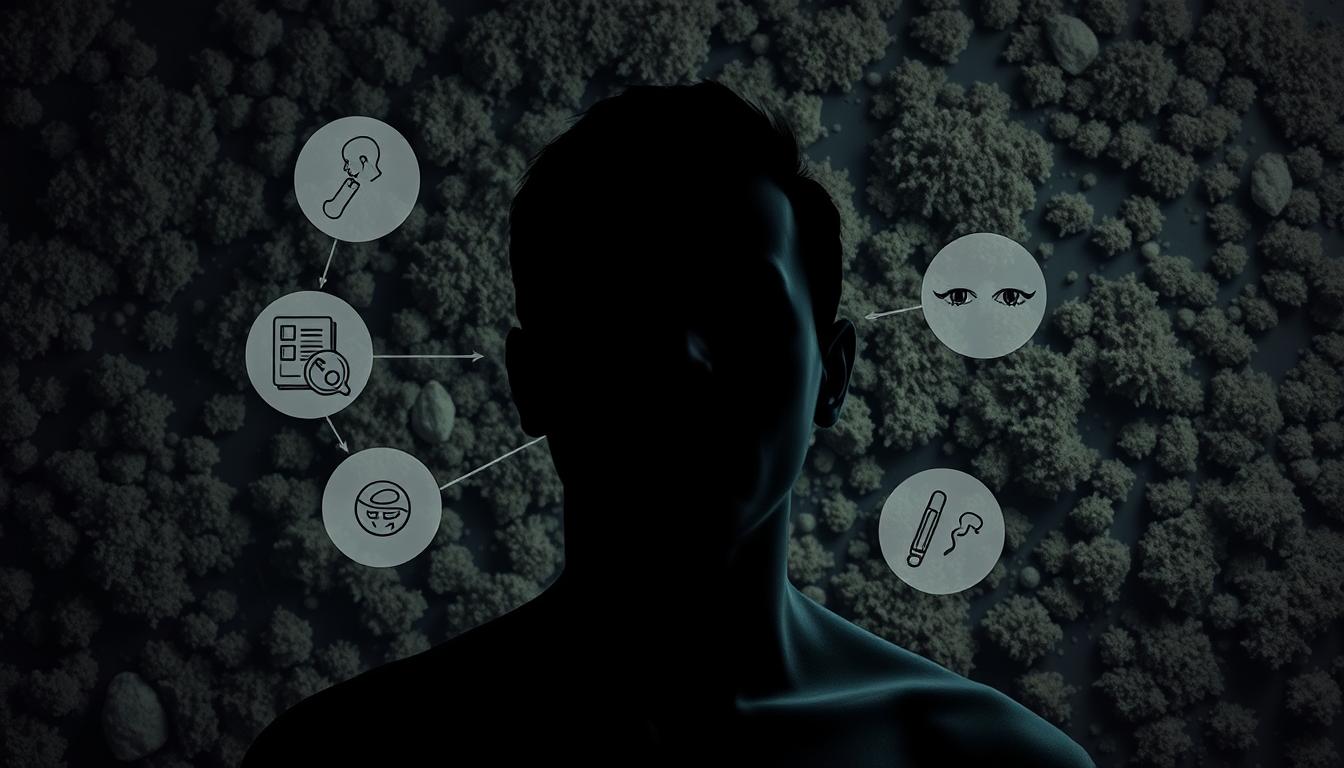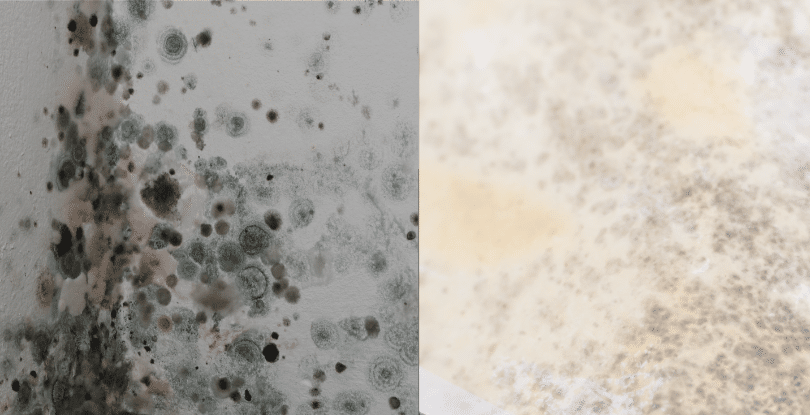Symptoms of Long Term Mould Exposure
Did you know mold is found in every public building studied? On average, there are 14 instances of mold per building. This shows how widespread mold is indoors. Long-term exposure to mold can harm your health, causing many symptoms that affect your life quality.
I’ve dealt with mold exposure myself. It’s tough to understand mold-related illnesses. Symptoms range from breathing problems to skin issues and brain effects. Knowing the signs and acting fast is key to dealing with mold.
Key Takeaways
- Mold exposure can cause a wide range of health effects, from mild allergic reactions to severe, chronic illnesses.
- Common symptoms of long-term mold exposure include respiratory problems, skin irritation, cognitive issues, and immune system dysfunction.
- Certain occupations and living environments with high humidity or poor ventilation increase the risk of mold-related health problems.
- Early recognition and treatment of mold-related symptoms are crucial for managing the condition and preventing further complications.
- Proper mold remediation and preventive measures are essential for maintaining a healthy indoor environment.
Understanding Mould and Its Impact on Indoor Environments
Mold is a fungus that breaks down organic matter. It can grow indoors, posing health risks. Let’s look at the types of indoor mold, how it spreads, and where it grows.
Different Types of Indoor Mould Species
Mold spores are everywhere in the air we breathe. But, too much mold can harm our health, more so for those with breathing issues or weak immune systems. Common indoor molds include Cladosporium, Penicillium, and Aspergillus. They can grow on wood, carpets, and drywall.
How Mould Spreads in Buildings
Mold spreads through spores in the air, water, or on objects. Once it starts growing in a building, it can spread fast, mainly in damp areas. Keeping the air dry, controlling humidity, and fixing water leaks quickly are key to stopping mold.
Common Areas Where Mould Thrives
Bathrooms, basements, and areas with water damage are mold hotspots. Moisture from leaks, high humidity, or poor drainage helps mold grow. It’s important to find and fix these areas to keep your space healthy.
“Mold spores are always found in the air we breathe, but extensive mold contamination may cause health problems, with exposure to mold leading to health effects in some people.”
What Are the Symptoms of Long Term Mould Exposure
Long-term exposure to mold can harm your health. It can cause many symptoms. These include respiratory issues like nasal congestion and wheezing. It can also lead to eye irritation, skin rashes, and headaches.
People with allergies, asthma, or weak immune systems are more at risk. They may have more severe reactions to mold.
Continued exposure to mold can make existing health problems worse. It can also lead to chronic health issues. Some common symptoms of long-term mold exposure include:
- Respiratory problems: Nasal congestion, sneezing, wheezing, and chronic cough
- Eye irritation: Redness, itchiness, and watery eyes
- Skin reactions: Rashes, hives, and eczema
- Headaches and fatigue: Persistent, unexplained headaches and feelings of tiredness
- Neurological effects: Memory problems, brain fog, and difficulty concentrating
- Immune system issues: Increased susceptibility to infections and allergic responses
If you’re experiencing these symptoms and think it might be mold, act fast. Fixing the source of the problem, like a leaky pipe or bad ventilation, can help. It can reduce your exposure and ease your symptoms over time.

“Mold exposure can have a significant impact on our health, leading to a range of uncomfortable and sometimes debilitating symptoms. It’s important to be proactive in identifying and addressing any mold issues in your home or workplace.”
Black Mould: A Common Household Health Threat
Black mold, also known as Stachybotrys chartarum, is a fungus that grows on materials like wood and drywall. It needs moisture to grow, making it common in damp places.
Identifying Stachybotrys Chartarum
Stachybotrys chartarum, or “toxic black mold,” can produce harmful compounds. It’s not more dangerous than other molds, but its toxins are a big worry for homeowners.
Why Black Mould Is Particular Concerning
The National Institute of Environmental Health Sciences says black mold can cause health problems like allergies. The Centers for Disease Control and Prevention (CDC) also notes that it can make asthma worse.
People with weak immune systems, like those with HIV or cancer patients, are more at risk. The CDC says mold can cause serious reactions in people who work with it, like farmers.
There’s debate about “toxic mold syndrome” because there’s no solid proof of its effects. But the CDC says there are rare health issues from mold in homes.
It’s key to get rid of all mold to keep homes clean and healthy. For serious cases, getting help from professionals is best.
Respiratory Symptoms and Chronic Breathing Issues
Mold can harm our breathing. It can cause a chronic cough, wheezing, and shortness of breath. These problems can really affect our daily life. People with asthma might find it even harder to breathe because of mold.
Mold spores can make our airways itch and cause allergies. Being around mold for a long time can lead to breathing problems that last forever. It might even cause asthma, mostly in kids. It’s very important to fix mold problems at home to keep our air clean and our lungs healthy.
| Respiratory Symptom | Connection to Mould Exposure |
|---|---|
| Chronic Cough | Mold can irritate the lungs and airways, leading to persistent coughing. |
| Wheezing | Mold can cause inflammation and constriction of the airways, resulting in wheezing. |
| Shortness of Breath | Mold exposure can make it difficult to breathe, specially for those with pre-existing respiratory conditions. |
| Asthma Exacerbation | Mold can trigger and worsen asthma symptoms, leading to more frequent and severe attacks. |
We need to find and fix the reasons mold grows. We also need to reduce how much we’re exposed to it. Keeping an eye on things, making sure air moves well, and fixing any moisture problems can help. This way, we can keep our air clean and our lungs healthy.

Neurological Effects and Cognitive Symptoms
Prolonged exposure to mold can significantly affect the brain and thinking. Mold-related cognitive issues, like memory problems and brain fog, are common. Studies suggest a link between mold and these symptoms, but the exact reasons are still unclear.
Memory Problems and Brain Fog
People exposed to mold often struggle with memory, focus, and mental clarity. Brain fog is a term for feeling confused, forgetful, and mentally slow. These issues can make everyday tasks hard and lower quality of life.
Mould Exposure Headaches and Mental Health Impact
Headaches are a common symptom of long-term mold exposure. These mold exposure headaches can be mild or severe. They may also cause dizziness or sensitivity to light and sound. Mold exposure can also raise the risk of mental health problems like anxiety and depression.
Sleep Disturbances
Mold in living spaces can mess up sleep, causing insomnia, restlessness, and poor sleep quality. This can worsen cognitive symptoms and harm overall well-being.
While we don’t fully understand the link between mold and brain effects, research points to inflammation. Mold and mycotoxins may trigger this inflammation. People with weak immune systems are more at risk.
“Exposure to mold and mycotoxins can lead to a wide range of neurological symptoms, from memory problems and brain fog to headaches and sleep disturbances. It’s crucial to address mold issues in the home to protect your cognitive health.”
Skin Reactions and Dermatological Signs
Mold exposure can cause skin reactions like mold-induced skin rashes, dermatitis, and fungal skin infections. Touching mold spores can irritate the skin, cause inflammation, and lead to serious skin problems in some cases.
People with sensitive skin or existing skin conditions are more likely to react to mold. If you have skin issues in damp or moldy places, it might be due to mold. You should get it checked and treated quickly.
Common signs of mold-related skin reactions include:
- Itchy, dry, and scaly skin
- Raw, sensitive, and inflamed skin
- Brown or pinkish discoloration
- Small, raised bumps that may leak fluid
Mold allergies can cause atopic dermatitis or eczema. This makes the skin dry, itchy, and more likely to get worse. Blood tests or skin prick tests can help find out why you have these skin problems.
| Mould Allergy Symptoms | Mould Rash Symptoms |
|---|---|
| Sneezing, runny nose, itchy eyes | Itchy, dry, scaly skin |
| Coughing, chest tightness | Raw, sensitive, inflamed skin |
| Worsening asthma symptoms | Brown or pinkish discoloration |
| Fever, shortness of breath | Small, raised bumps that may leak fluid |
Treating mold-related skin problems might need medicines like antihistamines, corticosteroid creams, and antibiotics. Home remedies like aloe vera, cold compresses, and oatmeal baths can also help. If your rash doesn’t get better or if you have other symptoms, see a doctor.
“Mold reproduces through spores carried in the air, which can trigger an allergic reaction leading to symptoms like rashes.”
Immune System Response to Prolonged Mould Exposure
Being around mold for a long time can really hurt our immune system. It makes us more likely to have allergic reactions and become sensitive to things. Our body keeps reacting to mold, leading to many bad symptoms.
Allergic Reactions and Sensitivities
Mold is a strong allergen. People who are sensitive to it might sneeze, have itchy eyes, and trouble breathing. In some cases, mold can make new allergies or make old ones worse.
Compromised Immune Function
Mycotoxins, harmful substances from some mold, can really hurt our immune system. These toxins make it harder for our body to fight off sickness. This makes us more likely to get sick and have long-term health problems.
People with weak immune systems, like those with cancer or HIV/AIDS, are at a higher risk. They need to be extra careful and see a doctor right away if they think mold is making them sick.
Mold can also make existing immune problems worse. This is why it’s so important to deal with mold in our homes or workplaces.
“An estimated 24% of the world’s population has a gene (HLA-DR) that may prevent the immune system from properly identifying and removing mold toxins, resulting in illness from mold exposure.”
High-Risk Groups and Increased Susceptibility
Some people are more at risk from mold exposure. This includes those with weakened immune systems and the elderly. Knowing who is most vulnerable helps us protect them better.
Those with allergies, asthma, or lung diseases are more likely to suffer from mold. The Centers for Disease Control and Prevention notes that common indoor molds include Cladosporium, Penicillium, Aspergillus, Alternaria, and Stachybotrys chartarum (black mold). These can make breathing harder and worsen existing health issues.
People with weakened immune systems, like those with HIV/AIDS or undergoing chemotherapy, are also at risk. A study funded by NIEHS found that mold exposure in the first year of life may increase childhood asthma risk.
The elderly and young children are also more vulnerable to mold. NIEHS supported a study after Hurricane Katrina, which helped reduce asthma symptoms in children.
Pregnant women are another high-risk group. Mold exposure can harm both the mother and the developing fetus. Climate change is making mold spread worse, leading to more dampness and warmer temperatures.
By identifying these high-risk groups and taking steps to reduce mold, we can protect them. This is crucial for those with mold sensitivity, immunocompromised individuals, and elderly mold risks.
Hidden Sources of Mould in Your Home
As a homeowner, it’s crucial to watch for hidden mold in your home. Mold can grow in spots you can’t see, like behind wallpaper or under carpets. Knowing where mold often hides and what to look for helps you tackle these issues early.
Common Problem Areas
Some areas of your home are more likely to have mold. This includes basements, bathrooms, and places with past water damage. Also, damp HVAC systems and wet subfloors can be mold hotspots.
Signs of Hidden Mould Growth
Finding hidden mold can be tough, but there are clues. A strong, musty smell is a big sign, even if you can’t see the mold. If you’re feeling stuffy, itchy, or have skin issues, mold might be the culprit. Also, look for discoloration on walls or ceilings, which could mean mold is hiding.
FAQ
What are the symptoms of long-term mould exposure?
Long-term mold exposure can cause many symptoms. These include respiratory issues like nasal congestion, wheezing, and coughing. It can also cause eye irritation, skin rashes, headaches, and fatigue.
Some people may have more severe reactions. This is true for those with allergies, asthma, or weakened immune systems. Prolonged exposure can lead to chronic health problems and worsen existing conditions.
What are the different types of indoor mould species?
Common indoor mold species include Cladosporium, Penicillium, and Aspergillus. These molds can grow on various surfaces like wood, carpets, and drywall. They thrive in moist environments, such as bathrooms, basements, and areas with water damage.
How does mould spread in buildings?
Mold reproduces through spores that can spread through air, water, or animals. Mold spores are found both indoors and outdoors. They can grow in hidden areas of homes, such as behind wallpaper, under carpets, or inside air ducts.
What are the common areas where mould thrives?
Mold grows in moist environments, like bathrooms, basements, and areas with water damage. Signs of hidden mold growth include musty odors, discoloration on walls or ceilings, and unexplained health symptoms.
What is black mould, and how is it different from other types of mould?
Black mold, often referring to Stachybotrys chartarum, is a dark green or black fungus. It grows on materials with high cellulose content and needs constant moisture. While black mold can cause allergic reactions and respiratory issues, it’s not necessarily more dangerous than other types of mold.
The severity of symptoms depends on individual sensitivity and the duration of exposure.
What are the respiratory symptoms associated with long-term mould exposure?
Mold exposure can cause respiratory symptoms like coughing, wheezing, and shortness of breath. People with asthma or other respiratory conditions may experience more severe reactions. Long-term exposure can lead to chronic respiratory issues and may contribute to the development of asthma in children.
Can mould exposure affect cognitive function and neurological symptoms?
Some people report neurological symptoms associated with long-term mold exposure. These include memory problems, difficulty concentrating, and headaches. While the connection between mold and these symptoms is not fully understood, some studies suggest a potential link.
Sleep disturbances and mood changes have also been reported by individuals exposed to mold for extended periods.
What are the skin reactions and dermatological signs of mould exposure?
Mold exposure can cause skin reactions like rashes, itching, and hives. Direct contact with mold spores can lead to skin irritation or fungal infections in some cases. People with sensitive skin or pre-existing skin conditions may be more susceptible to mold-related dermatological issues.
How can mould exposure affect the immune system?
Prolonged mold exposure can affect the immune system, leading to increased allergic reactions and sensitivities. Some individuals may develop chronic inflammatory responses. While rare, people with compromised immune systems may be at risk of more serious fungal infections.
Mold exposure can potentially exacerbate existing immune-related conditions.
Who is most susceptible to mould-related health issues?
Certain groups are more susceptible to mold-related health issues. These include individuals with allergies, asthma, or chronic lung diseases. People with compromised immune systems, such as those with HIV/AIDS or undergoing chemotherapy, are at higher risk of fungal infections.
The elderly, young children, and pregnant women may also be more sensitive to mold exposure effects.




